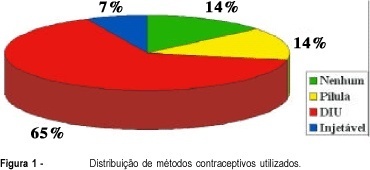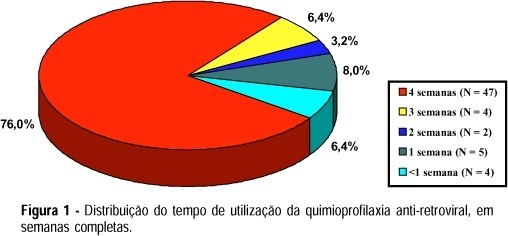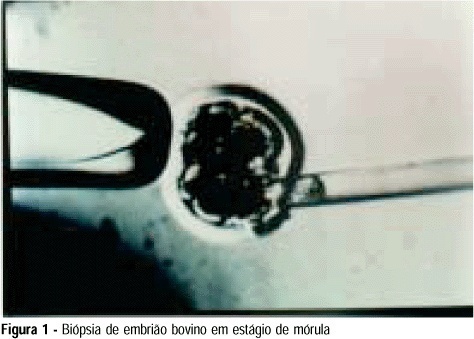Summary
Revista Brasileira de Ginecologia e Obstetrícia. 1999;21(8):441-445
DOI 10.1590/S0100-72031999000800003
SUMMARY Purpose: to estimate the prevalence of Candida sp. and the distribution of its species in the vagina of women attended at a family planning Service. Methods: a cross-sectional study evaluating prospectively 72 nonpregnant women, with or without specific complaints. Samples were checked for the presence of yeast and vaginal pH. Data obtained by gynecologic examination were also recorded. Results: yeast belonging to the genus Candida was isolated from 18 (25%) patients. The most prevalent species was C. albicans (77,8%) and therefore, 22.2% were non-albicans species. The most prevalent among the non-albicans species was C. glabrata (16.7%) followed by C. parapsilosis (5.6%). The symptoms most directly associated with Candida were itching and burning. Different from the symptoms directly associated with C. albicans infection, we observed that C. glabrata does not cause vaginal discharge. There was no positive association between predisponent factors such as age, education and contraceptive method used and the presence or absence of Candida. Conclusions: our results suggest: (i) that there is a high prevalence of Candida species among women; (ii) that non-albicans species play an important role in the vaginal medium; (iii) that itching and burning are the most common symptoms in women with Candida, and (iv) C. glabrata usually does not cause vaginal discharge. Finally, it is important to emphasize that our results are consistent with the present worldwide findings.

Summary
Revista Brasileira de Ginecologia e Obstetrícia. 1999;21(8):431-437
DOI 10.1590/S0100-72031999000800002
Purpose: to evaluate risk factors and papillomavirus (HPV) associated lesions in male partners of women with genital intraepithelial neoplasia. Patients and Methods: three hundred and thirty-seven men were evaluated by urethral cytology, peniscopy, and biopsy, if necessary. We analyzed the results and the relations to age, educational level, smoking, contact time with the present partner, age at first intercourse, number of partners, previous sexually transmitted diseases (STD), circumcision, peniscopic findings, and female lesion grade. Results: peniscopy was positive in 144 (42,7%) and HPV infection was diagnosed in 105 (31,2%). Smoking, contact time with the present partner up to 6 months, and more than one previous sexual partner were associated with HPV lesions (p<0,05). The urethral cytology was suspect in 4,2% and smoking, positive peniscopy or biopsy and partners of women with high-grade lesion (p<0,05) were associated with the diagnosis. 72.1% of 229 biopsies were positive, independently of the peniscopic findings and women's lesion grade. Conclusions: HPV infection was diagnosed in 31.2% and was associated with smoking, contact time with the present partner up to 6 months and more than one previous sexual partner, but not with the female lesion grade, educationa level, previous STD, circumcision and peniscopic findings.
Summary
Revista Brasileira de Ginecologia e Obstetrícia. 1999;21(9):555-559
DOI 10.1590/S0100-72031999000900009
Purpose: high parity and/or young age at first sexual intercourse have been reported as risk factors for cervical cancer development. Actually, little research has been devoted to these risk factors. The aim of the present study was to analyze the parity and age at first sexual intercourse in women with invasive cervical cancer. Methods: we have retrospectively studied the age at first sexual intercourse and parity of 362 women with invasive cervical cancer diagnosed at the Outpatient Clinic of Oncological Gynecology of the "Faculdade de Medicina do Triângulo Mineiro" from 1978 to 1995. The cases were analyzed according to the date of diagnosis and divided into three groups: from 1978 to 1983 with 65 cases, from 1984 to 1989 with 127 cases and from 1990 to 1995 with 170 cases. Results: the results showed that high parity (4 or more births) diminished from the first to the third period (82, 67.3 and 63.8%, respectively) (p<0.02, chi² test). The first sexual intercourse before 18 years occurred respectively in 59.2, 54.5 and 55.5% of the patients (p, not significant). Conclusions: it was concluded that high parity seems to be related to invasive cervical cancer, although in recent years the parity decreased. The first sexual intercourse occurred before the age of 18 years in the patients of the three periods.
Summary
Revista Brasileira de Ginecologia e Obstetrícia. 1999;21(9):549-552
DOI 10.1590/S0100-72031999000900008
Purpose: to evaluate the correlation between clinical and surgical staging of patients with vulvar carcinoma, according to the "Federação Internacional de Ginecologia e Obstetrícia" (FIGO 95). Methods: the authors studied 66 consecutive cases of vulvar carcinoma from 1977 to 1997. All patients were clinically staged to verify size and localization of the lesion as well as inguinal lymph node involvement and invasion of other organs. Forty-four patients were submitted to surgical treatment and 34 could be staged according to FIGO 95. Results: among the 34 patients staged through surgery, 17 (50%) showed agreement between clinical and surgical staging. Thus, in 17 patients the staging was different and in these the surgical staging was higher than the clinical in 13 cases and lower in 4 cases. We found in the clinical staging I, 2 cases that were surgical stage II and 1 case that was surgical stage III. Conclusion: the surgical staging could detect lymph node metastasis in patients with clinically negative nodes, as well as exclude false-positive cases. The clinical staging was not accurate for patients with vulvar carcinoma.
Summary
Revista Brasileira de Ginecologia e Obstetrícia. 1999;21(9):539-544
DOI 10.1590/S0100-72031999000900007
Purpose: some medical institutions have been prophylactically ministrating anti-HIV therapy in cases of sexual violence, although there are no appropriate basic facts to establish its efficacy. The aim of the present study was to evaluate the acceptance, tolerance and adhesion of these women under a chemoprophylaxis plan for HIV. Methods: sixty-two women victims of rape and/or anal intercourse with unknown aggressors have been evaluated. Prophylaxis has been started within the first 48 h after violence and maintained for 4 weeks, with daily administration of zidovudine, 600 mg; indinavir, 2,400 mg and lamivudine, 300 mg. Results: the discontinuance rate was 24.2%, withe 12 cases (80%) due to gastric intolerance. The side effects were present in 43 cases (69.4%), including nausea and vomitting as the most frequent. Complex dosage and time of administration were factors possibly related to the inadequate use of the drugs in 10.6% of the cases. Conclusion: the authors concluded that the chemoprophylaxis discontinuance rate was similar to that observed in other indications.

Summary
Revista Brasileira de Ginecologia e Obstetrícia. 1999;21(9):533-538
DOI 10.1590/S0100-72031999000900006
Purpose: to develop an animal model for the study of, and training in, bovine biopsies. Methods: cow ovaries were obtained from a slaughterhouse and transported to the laboratory where the oocytes were aspirated, maturated and submitted to in vitro fertilization. On the 5th day after fertilization, the embryos were biopsied, with the zona pellucida being opened with a cutting blade fitted to the light microscope. One or two blastomeres were removed from the embryos and left in coculture for three additional days. After this time, embryo development was evaluated in comparison to a control group by morphological study and cell counts using specific staining for nuclei. Results: forty of the 57 biopsied embryos reached the blastocyst stage (70.2%) and hatching was observed in 11 (27.5%). Forty-two blastocysts were obtained in the control group (73.7%) and 11 of them hatched (26.2%). Cell counts showed no significant differences between groups. Conclusions: we conclude that the proposed protocol is technically feasible and supplies a good number of embryos because of the easy technique for obtaining bovine oocytes, thus representing a method that could be adopted for training.

Summary
Revista Brasileira de Ginecologia e Obstetrícia. 1999;21(9):527-531
DOI 10.1590/S0100-72031999000900005
Purpose: to compare the efficacy and safety between two doses of intravaginal misoprostol for cervical ripening and induction of labor. Patients and Methods: sixty-one patients with medical indication for induction of labor and unfavorable cervix were included in this study. Twenty-eight of them received 25 µg and thirty-three 50 µg misoprostol, every four hours until delivery. Results: premature rupture of membranes, prolonged gestation and preeclampsia were the main indications for labor induction. The time interval, in minutes, from insertion of misoprostol until delivery was similar for the 25 µg (416.3 ± 148.1) and 50 µg (425.0 ± 135.9) groups. The percentage of vaginal delivery was 82.2% and 81.9% in the groups of 25µg and 50 µg, respectively. There was no significant difference between the two groups regarding fetal or maternal complications. Conclusions: the administration of intravaginal misoprostol was shown to be an efficient and safe method for cervical ripening and induction of labor. The dose of 25 µg was similarly effective and safe when compared to 50 µg.
Summary
Revista Brasileira de Ginecologia e Obstetrícia. 1999;21(9):519-525
DOI 10.1590/S0100-72031999000900004
Purpose: to present the perinatal outcomes resulting from the use of a protocol for assistance to diabetic pregnant women used at the Center for Integral Assistance to Women's Health (CAISM), of the University of Campinas. Methods: ninety diabetic pregnant women, who were assisted at the institution with this protocol, were compared with two control grups: the first consisted of 180 pregnant women with equal number of gestations and same age (control A) and the second consisted of 180 randomly selected pregnant women (control B). The study variables were route of delivery, indication for cesarean section, gestational age, Apgar score at first and fifth minute, weight, adequacy of weight for gestational age and perinatal morbidity and mortality. For the statistical analysis Student's t-test and the chi2 test were used. Results: there was a higher incidence of cesarean sections, prematures and large to gestational age (LGA) babies among diabetic women, as well as higher occurrence of neonatal morbidity such as hypoglycemia, hypocalcemia, hyperbilirubinemia, respiratory distress and neonatal depression. The incidence of low Apgar score and perinatal mortality was significantly higher than in the randomly selected group, but the same as in the group matched regarding age and number of pregnancies. Conclusions: although this protocol intends to obtain a perfect metabolic control among diabetic pregnant women, the perinatal outcomes are still unfavorable in comparison to nondiabetic pregnant women.